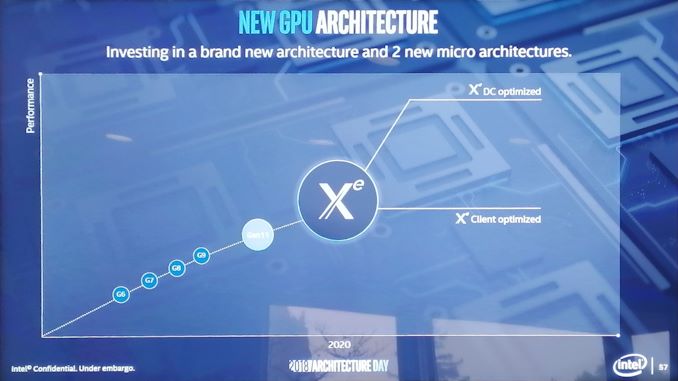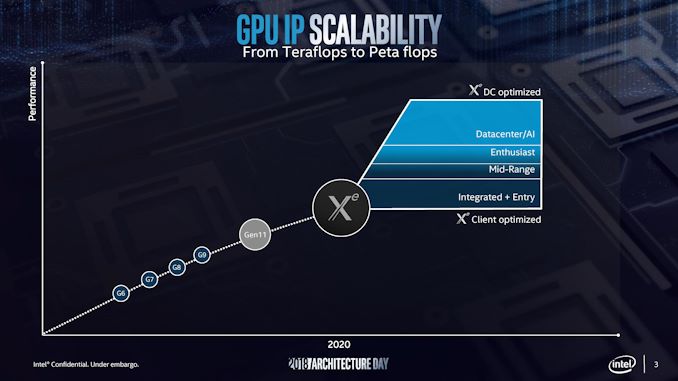Intel's Architecture Day 2018: The Future of Core, Intel GPUs, 10nm, and Hybrid x86
by Dr. Ian Cutress on December 12, 2018 9:00 AM EST- Posted in
- CPUs
- Memory
- Intel
- GPUs
- DRAM
- Architecture
- Microarchitecture
- Xe
Going Beyond Gen11: Announcing the XE Discrete Graphics Brand
Not content with merely talking about what 2019 will bring, we were given a glimpse into how Intel is going to approach its graphics business in 2020 as well. It was at this point that Raja announced the new product branding for Intel’s discrete graphics business:
Intel will use the Xe branding for its range of graphics that were unofficially called ‘Gen12’ in previous discussions. Xe will start from 2020 onwards, and cover the range from client graphics all the way to datacenter graphics solutions.
Intel actually divides this market up, showing that Xe also covers the future integrated graphics solutions as well. If this slide is anything to go by, it would appear that Intel wants Xe to go from entry to mid-range to enthusiast and up to AI, competing with the best the competition has to offer.
Intel stated that Xe will start on Intel’s 10nm technology and that it will fall under Intel’s single stack software philosophy, such that Intel wants software developers to be able to take advantage of CPU, GPU, FPGA, and AI, all with one set of APIs. This Xe design will feed the foundation of several generations of graphics, and shows that Intel is now ready to rally around a brand name moving forward.
There was some confusion with one of the slides, as it would appear that Intel might be using the new brand name to also refer to some of it's FPGA and AI solutions. We're going to see if we can get an answer on that in due course.












148 Comments
View All Comments
zodiacfml - Thursday, December 13, 2018 - link
YESRaqia - Thursday, December 13, 2018 - link
For ultra-mobile, not only are battery/power/heat issues but supply is one as well due to Intel being locked down to their own manufacturing division. On top of that, they have a lock on x86 by not licensing to any competitors but AMD, who despite competitive stretches inevitably stumbles (either due to themselves or Intel's non-engineering financial efforts) and leaves the industry with dry spells of performance improvements. Intel's gross margins on their chips remain >60% as a result whereas ARM SoCs even after licensing is closer to 20-30%.Raqia - Thursday, December 13, 2018 - link
Keller declared that the technology is in its infancy, and feature wise the 2019 version of the Atom simply won't be competitive with leading ARM SoCs like the 8cx. The slowness you refer to only occurs when running native 32 bit x86 code on the WOW emulation layer, but the value of this feature is mostly in the compatibility being there at all. If performance and compatibility of legacy code matters to you then certainly Windows on Arm isn't suitable. However, it will matter even less now with the new native compilation tools and ports of important sub platforms like Chromium.29a - Thursday, December 13, 2018 - link
"Windows on ARM is horribly slow and therefore shitty."Sounds a lot like Windows on Atom.
MonkeyPaw - Saturday, December 15, 2018 - link
I’m betting Apple wanted one for MacBook Air, or maybe MS for Surface Go. It would be the right amount of performance for both devices, an both companies would have the clout to get it done. I’d lean toward Apple because the GPU is pretty big.Kevin G - Wednesday, December 12, 2018 - link
Typo:"a physical address space up to 52 bits. This means, according to Intel, that the server processors could theoretically support 4 TB of memory per socket."
That should be petabytes instead of terabytes. The limit is for an entire system, not per socket as additional sockets will not grant any additional capacity.
gamerk2 - Thursday, December 13, 2018 - link
NUMA systems could potentially be per-socket rather then OS wide.HStewart - Wednesday, December 12, 2018 - link
It sounds like Intel has been working on increasing performance in two ways1. 7nm change for the future - because of limitations found with 10nm
2. 10nm enhance for corrections for performance of issues with Cannon Lake
But most importantly, architexture improvements like faster single thread execution and new instructions and multi-core improvements will in long term significantly improve performance
ishould - Wednesday, December 12, 2018 - link
Forgive me if I take 2 metric tons of salt with any roadmaps Intel provides these days. They haven't exactly had the most accurate timelines as of late (past four years)HStewart - Wednesday, December 12, 2018 - link
It appears they realize that and coming out with document to indicated they have made corrections - this is better than not knowing what they are planning - or as some AMD Fans would like to believe that they lost the battle.